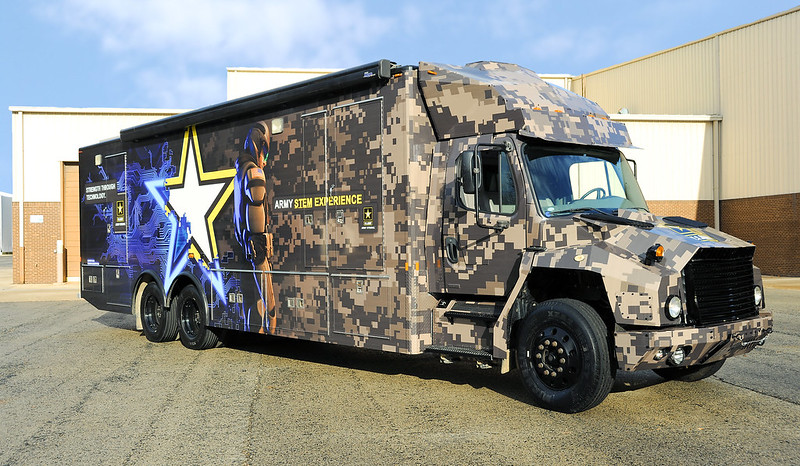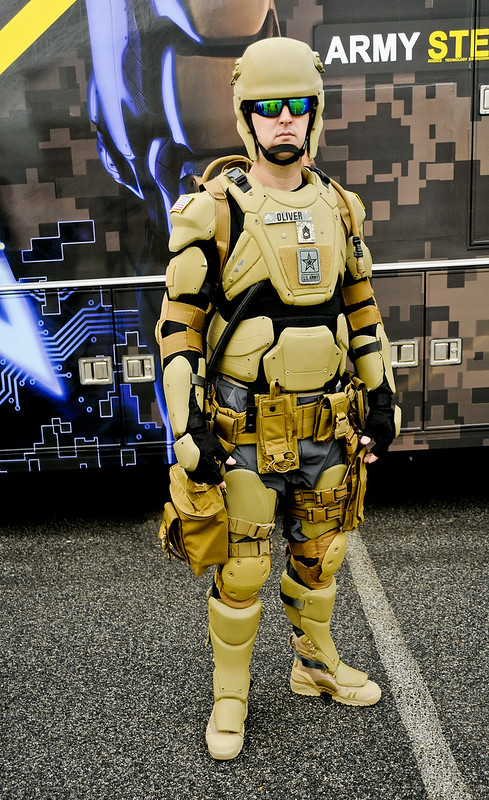Ed Alert: Military Teaches Our Kids

There’s a saying in the Army recruiting community: “First to contact, first to contract.” In the United States, you have to be at least 17 years old to enlist in the armed forces. But, according to those who make a living tracking students’ feelings about the military, it would be pure folly not to start before then. Enter public education. In 2010, the most recent year for which data are available, the Department of Defense (DoD) was administering more than a dozen different programs and spending close to $50 million on K-12 outreach targeting the STEM fields of science, technology, engineering, and math.
As school budgets continue to be decimated, it can be hard for some educators to turn down free STEM education. “The Pentagon has money,” as Corey Mead puts it in his book War Play, “and our public schools are starved for funds.” In their enthusiasm for Pentagon-supported STEM initiatives, educators can forget to check whether there are other motives besides spurring a love of science in the young. In fact, by avoiding the “recruitment” label, the military is able to use STEM education as a Trojan horse to gain access to students and plant the seeds for eventual recruitment.
Militarizing the STEM Curriculum
One of the DoD’s largest K-12 programs is the Army Educational Outreach Program (AEOP), which consists of at least nine distinct STEM educational programs. During the 2011-12 academic year, the AEOP reached nearly 53,000 students. John Parmentola, Army director of research and laboratory management, says that one of the AEOP’s goals is to encourage youth so that “someday some of them may decide to work in an Army laboratory or join the Army with an understanding of how technical fields support the Army’s mission.”
The AEOP’s marquee program is eCybermission, a web-based STEM competition for students in grades 6 through 9. Working in groups of three or four, students first identify a community problem they would like to solve; past examples have included improving the energy efficiency of one’s school and improving the health of a local lake. They then work with adult advisors, usually teachers, to develop a workable solution based on science or engineering principles. Partly because it costs nothing for schools to participate, and perhaps because winning contestants receive hundreds of dollars in U.S. savings bonds, the number of students participating in eCybermission has grown from 4,000 in 2002 to more than 20,000 in 2013.
The language of eCybermission makes liberal use of military lingo. Students place their notes and data in a Mission Folder. If they get stuck on a problem they can always call up a cyberguide at Mission Control, in which case they have a 50 percent chance of communicating with a soldier. (The biography of one cyberguide, listed on the AEOP website, notes that his background includes the “development and testing of software used to aim, load, and shoot howitzers.”) Once the competition ends, uniformed “Army ambassadors” often visit schools to hand out prizes to students.
All of which raises some basic questions about the Army’s motives. When I talked with Louie Lopez, chief of STEM/ educational outreach for the Army, he denied that the program was steering 6th graders toward a military career. “We are not recruiting them into the Army or the [Army’s] labs,” he said. “We believe that whether they enter science as a solider or civilian, as a teacher or just as part of the community, that’s just as well.” But, he conceded, “Of course we want them to know that there is some highly technical science and engineering taking place [in the Army].” He added that part of what eCybermission is doing is “correcting misperceptions” about the military. “For the most part, schools just think the Army is about recruiting and fighting wars.”
Chemical Attack as Teachable Moment
The Army STEM Experience, an 18-wheel traveling exhibit, uses video technology to thrust students into the year 2032, when they must use science to respond to a terrorist attack on a chemical plant. The exhibit is divided into three rooms, each filled with interactive video screens. One room employs touchscreen technology to put students in touch with a virtual team of Army officers and civilian scientists; students develop a “humanitarian” solution to the problem. In another, small groups of students design a “futuristic response to the crisis.” One option presented to them involves deploying unstaffed aerial vehicles—in other words, drones.
The exhibit also educates students about Army opportunities in STEM fields. A slide from a declassified Army PowerPoint presentation describes the Army STEM Experience as “designed to showcase hi-tech capabilities and opportunities within the Army, while generating quality leads for local recruiters.” Of the four recruiters driving and staffing the exhibit, one always wears Hollywood-style mock body armor. Katie Everett, STEM outreach coordinator with the U.S. Army Research, Development and Engineering Command, told a reporter for the Army News Service that a good return on investment would be for students to leave “with the overall impression, ‘I had no idea the Army did this. I want to do this for a living.'”

Is Anyone Too Young to Recruit?
“High school juniors and seniors are the main audience for the Army STEM Experience,” Matt Leas, chief of market integration with the Army Marketing and Research Group, assured me. Yet the Army has posted photos on its STEM Experience Facebook page showing elementary-aged children posing with soldiers. When confronted with these photos, Leas acknowledged that sometimes younger children did interact with the exhibit. Although the focus is on juniors and seniors, he wrote in a follow-up email, “we do not preclude other age groups from participating. As far as the frequency that the STEM experience interacts with younger kids, it would be impossible to quantify because of the ad hoc nature of how it occurs. Bottom line: That is not our focus.”
Not satisfied, I kept digging. I soon discovered that early in 2013 the Army STEM Experience visited an elementary school in Kentucky. Some of the soldiers staffing the exhibit then visited the same children on another occasion to participate in a school event, Pajama Day. An Army news release later noted that one of the soldier’s PJs “were a hit with the students.”
Teachers: Beware of Soldiers Bearing Gifts
These programs are just two examples of how the military uses STEM education to “penetrate schools” (in the Army’s phrasing) with military messaging. In places like Portland, Oregon, where activists have forced the school district to restrict the access of military recruiters to students, offering free STEM programming allows the military to circumvent local policies.
These programs raise fundamental questions about who controls our schools and curriculum. Teachers, often adept at sniffing out corporate-sponsored content, need to apply an equally critical lens to STEM programs by asking: Who is the sponsor? What are they hoping to gain by offering this program to schools?
Perhaps it all comes down to who is best qualified to be giving lessons about science and math, and supporting students in thinking critically about the political and social implications of scientific theories and discoveries—trained teachers? Or some soldiers in a semi?

